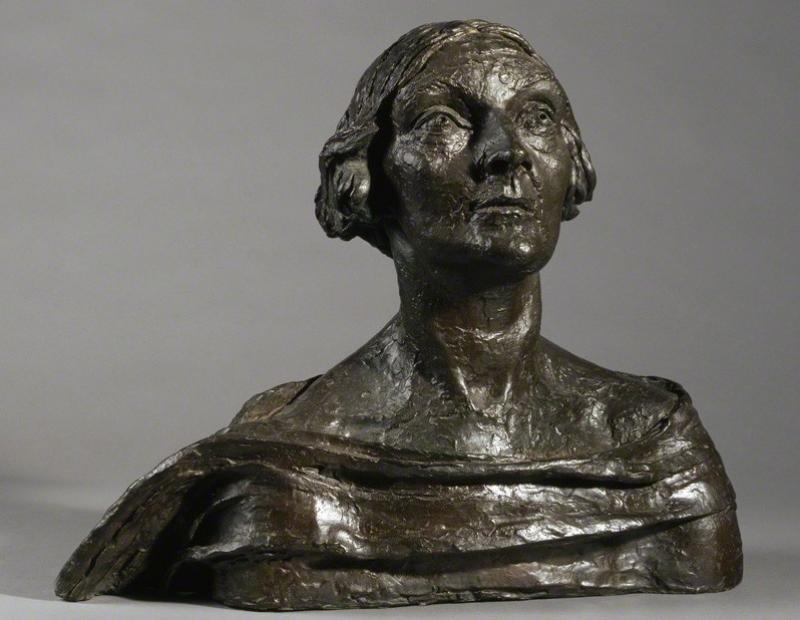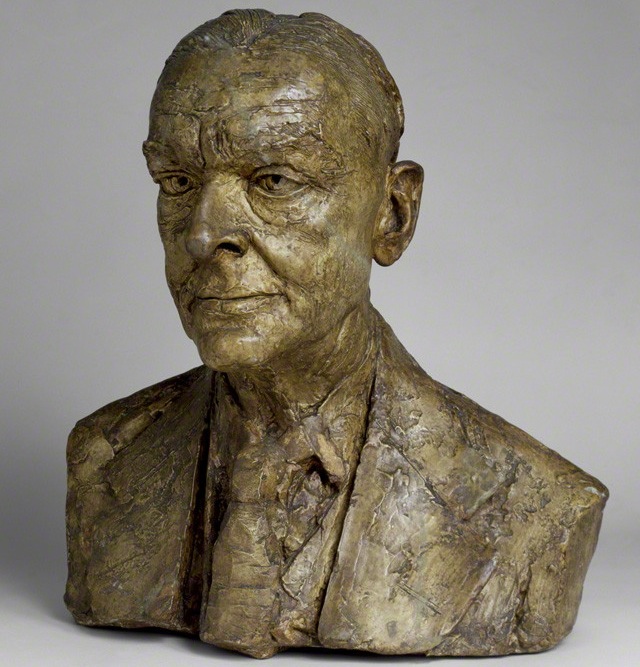Jacob Epstein: Portraits, National Portrait Gallery | reviews, news & interviews
Jacob Epstein: Portraits, National Portrait Gallery
Jacob Epstein: Portraits, National Portrait Gallery
The sculptor who got under the skin of his subjects and endowed them with an uncanny liveliness

“I don’t like the family Stein; There is Gert, there is Ep and there’s Ein; Gert’s Poems are bunk, Ep’s statues are punk, And nobody understands Ein” (Anon).
Jacob Epstein (1880-1959) did indeed sculpt Albert Einstein when the physicist was briefly interned in London on his way to America in 1933; Epstein’s bust of the quizzical shock haired scientist is currently on view at the Victoria and Albert. Epstein described his subject, already legendary, as humane, humorous and profound and was particularly struck by his hair going every which way.
Henry Moore said Epstein was the pioneer in taking all the abuse for modern artists
The baker’s dozen of portrait busts by Epstein in the new display at the National Portrait Gallery distils his talent, and shows that a contemporary retrospective is long overdue. The show is amplified by a series of portrait and studio photographs: here is Epstein at work on his portrait of Bertrand Russell, the subject gazing on benignly; here is Epstein in a photograph by Karsh, his own huge hand casually next to an enormous carved hand.
A Polish Russian Jew from New York’s Lower East Side, Epstein was studying in Paris by the time he was 22, financed by royalties from his emotive drawings for a book called The Spirit of the Ghetto. Paris curiously did not appeal; in 1905 Epstein arrived in London armed with a letter from Auguste Rodin introducing him to George Bernard Shaw (several decades later, although friends, Epstein’s lively bust of Shaw was curiously not allowed in the house by Mrs Shaw).
A visit to the British Museum sealed his determination to live in London. He remained though in many ways a classic outsider, in spite of his love for sheepdogs. Massive and physically strong, he was forced to be mentally unusually robust too, for he and his work were relentlessly attacked and vilified. Anyone who decides to be a sculptor condemns himself to a life of hard labour. Thus Epstein on his life’s career, and he described himself as a worker when he was commissioned by the TUC. Henry Moore said Epstein was the pioneer in taking all the abuse for modern artists; yet in that cycle of rejection and acceptance he was knighted five years before he died.
 Abstract sculptor of the avant-garde early on, he never abandoned his pioneering stance but also became, as we see here, an incisive portraitist of a wide spectrum of politicians and artists. Churchill was too restless a sitter, even for Epstein, but from Ramsay Macdonald to T S Eliot (pictured right) Epstein captured some kind of inner core. He was forthright: he did a sharp featured bust of the young Lucian Freud, his son in law for several years, but went on to describe him as a spiv. As was frequently observed, Epstein wore his heart on his sleeve: he was huge in bulk and huge in appetite. It was entirely appropriate that one of his best known works is Oscar Wilde’s tomb in Paris.
Abstract sculptor of the avant-garde early on, he never abandoned his pioneering stance but also became, as we see here, an incisive portraitist of a wide spectrum of politicians and artists. Churchill was too restless a sitter, even for Epstein, but from Ramsay Macdonald to T S Eliot (pictured right) Epstein captured some kind of inner core. He was forthright: he did a sharp featured bust of the young Lucian Freud, his son in law for several years, but went on to describe him as a spiv. As was frequently observed, Epstein wore his heart on his sleeve: he was huge in bulk and huge in appetite. It was entirely appropriate that one of his best known works is Oscar Wilde’s tomb in Paris.
He captured the wildness, or as Epstein put it an untamed quality, that was the essence of the bohemian artist Augustus John, impressively substantial in the Epstein bronze. Epstein was a wild man himself in many respects, unafraid to defy convention, strikingly technically accomplished, fearless in the boldness of his visual ideas, embattled with controversial public commissions, and perhaps most unusual in his distinctive combination of high emotion, earthiness and genuine sophistication. Sybil Thorndike’s family commissioned her portrait which shows her in her famous role as St Joan (in Shaw's play), gazing skyward as if hearing voices (main picture). It is realistic, but also something else, capturing the creative aspiration of the actress remarkably without pretension or affectation.
It is critically fashionable to dismiss Epstein’s portraits. But more and more his empathy in capturing character becomes evident. Bronzes can look very lumpen in photographic reproduction, but this selection shows how Epstein’s manual dexterity, coupled with his ability to observe so closely, makes of the cool metal surfaces something endowed with an uncanny liveliness. We can almost hear his subjects’ very tone of voice.
Explore topics
Share this article
The future of Arts Journalism
You can stop theartsdesk.com closing!
We urgently need financing to survive. Our fundraising drive has thus far raised £49,000 but we need to reach £100,000 or we will be forced to close. Please contribute here: https://gofund.me/c3f6033d
And if you can forward this information to anyone who might assist, we’d be grateful.

Subscribe to theartsdesk.com
Thank you for continuing to read our work on theartsdesk.com. For unlimited access to every article in its entirety, including our archive of more than 15,000 pieces, we're asking for £5 per month or £40 per year. We feel it's a very good deal, and hope you do too.
To take a subscription now simply click here.
And if you're looking for that extra gift for a friend or family member, why not treat them to a theartsdesk.com gift subscription?
more Visual arts
 'We are bowled over!' Thank you for your messages of love and support
Much-appreciated words of commendation from readers and the cultural community
'We are bowled over!' Thank you for your messages of love and support
Much-appreciated words of commendation from readers and the cultural community
 Folkestone Triennial 2025 - landscape, seascape, art lovers' escape
Locally rooted festival brings home many but not all global concerns
Folkestone Triennial 2025 - landscape, seascape, art lovers' escape
Locally rooted festival brings home many but not all global concerns
 Sir Brian Clarke (1953-2025) - a personal tribute
Remembering an artist with a gift for the transcendent
Sir Brian Clarke (1953-2025) - a personal tribute
Remembering an artist with a gift for the transcendent
 Emily Kam Kngwarray, Tate Modern review - glimpses of another world
Pictures that are an affirmation of belonging
Emily Kam Kngwarray, Tate Modern review - glimpses of another world
Pictures that are an affirmation of belonging
 Kiefer / Van Gogh, Royal Academy review - a pairing of opposites
Small scale intensity meets large scale melodrama
Kiefer / Van Gogh, Royal Academy review - a pairing of opposites
Small scale intensity meets large scale melodrama
 Jenny Saville: The Anatomy of Painting, National Portrait Gallery review - a protégé losing her way
A brilliant painter in search of a worthwhile subject
Jenny Saville: The Anatomy of Painting, National Portrait Gallery review - a protégé losing her way
A brilliant painter in search of a worthwhile subject
 Abstract Erotic, Courtauld Gallery review - sculpture that is sensuous, funny and subversive
Testing the boundaries of good taste, and winning
Abstract Erotic, Courtauld Gallery review - sculpture that is sensuous, funny and subversive
Testing the boundaries of good taste, and winning
 Edward Burra, Tate Britain review - watercolour made mainstream
Social satire with a nasty bite
Edward Burra, Tate Britain review - watercolour made mainstream
Social satire with a nasty bite
 Ithell Colquhoun, Tate Britain review - revelations of a weird and wonderful world
Emanations from the unconscious
Ithell Colquhoun, Tate Britain review - revelations of a weird and wonderful world
Emanations from the unconscious
 Rachel Jones: Gated Canyons, Dulwich Picture Gallery review - teeth with a real bite
Mouths have never looked so good
Rachel Jones: Gated Canyons, Dulwich Picture Gallery review - teeth with a real bite
Mouths have never looked so good
 Yoshitomo Nara, Hayward Gallery review - sickeningly cute kids
How to make millions out of kitsch
Yoshitomo Nara, Hayward Gallery review - sickeningly cute kids
How to make millions out of kitsch
 Hamad Butt: Apprehensions, Whitechapel Gallery review - cool, calm and potentially lethal
The YBA who didn’t have time to become a household name
Hamad Butt: Apprehensions, Whitechapel Gallery review - cool, calm and potentially lethal
The YBA who didn’t have time to become a household name

Add comment